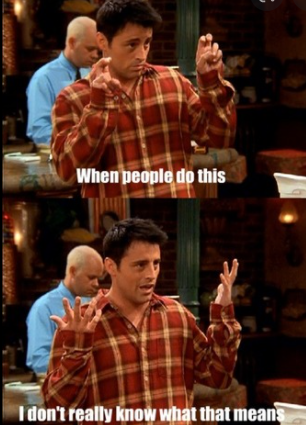Quotations are an indispensable part of writing—academic or otherwise. Even in verbal communication, we use the term “quote-unquote” when referring to an idea that is borrowed or when we want to avoid ownership of others’ thoughts. Using air quotes while speaking has also become a popular trope.
However, there are certain rules and regulations that govern the usage of quotation marks. Improper usage of quotation marks—especially in academic writing—can have implications ranging from inconsistency within the text to parts of the content being deemed plagiarized.
Brushing up on the rules pertaining to the proper use of quotations can help academic writers to create correct and consistent academic works.

(Image courtesy: https://quotesgram.com/joey-air-quotes/, Source: Friends (Season-9, Episode-2), Bright/Kauffman/Crane Productions, in association with Warner Bros)
When to use quotation marks?
There are three examples of quotation mark usage in academic writing: for emphasis, as scare quotes which are quotation marks used around a word or phrase to highlight an unusual or arguably inaccurate usage, and to quote another person.
Quotation marks for emphasis: One may use quotation marks to emphasize a certain word, for example:
COVID-19 swiftly transformed into a worldwide epidemic, which is called a “pandemic.”
However, most journals discourage authors from using quotation marks for emphasis and request the use of italics or boldface instead. This is because the emphatic use of quotation marks may clash with its use when actually quoting someone or the scare quotes.
Quotation marks used as scare quotes: One can think of scare quotes as the equivalent of the term “so called,” which is often used in verbal communication. These quotation marks can be used by the author to clarify that they do not personally endorse the idea presented. It is covertly informal in tone but can be used sparingly in academic writing. Scare quotes are more prevalent in papers from the Arts, Humanities, and Social Sciences than STEM, as the latter tends to be more specific and mostly includes accurate and statistically backed information. Here is an example of a scare quote used in academic writing.
Although considered “the weaker sex,” female athletes have been bringing home a plethora of medals.
Quotation marks used to quote others: This is the most widely used form of quotation marks in academic writing. It is used to denote a quote derived from a different source to support an argument.
Most ideas borrowed from other scholars are referenced within an academic text following the numbered (Vancouver) or author‒date (Harvard) style. However, some sections are presented in an academic paper verbatim as running text using quotation marks or as block quotes, if the quote has a higher word count. Block quotes are distinguished from the main text by using a different indentation and do not have opening and closing quotation marks; however, quotes within quotes can be presented in a block quote by using quotation marks.
Example of quotes used in a running sentence:
As Aristotle’s Poetics states, “With respect to the requirement of art, the probable impossible is always preferable to the improbable possible.”
Example of a block quote:
Aristotle’s Poetics states the following:
Thus, since time immemorial, it has been customary to accept the criticism of art from a man who may or may not have been artist himself. Some believe that artist should create its art and leave it for critic to pass judgement over it. Whereas dramatists like Ben Jonson is of the view that to “judge of poets is only the faculty of poets; and not of all poets, but the best”. Only the best of poets have the right to pass judgments on the merit or defects of poetry, for they alone have experienced the creative process form beginning to end, and they alone can rightly understand it.
American and British English variances
American and British English differ on their use of quotation marks.
American English:
- Double quotation marks (“…”) are used for quoted text, and single quotation marks (‘…’) are used to highlight a quote within a quote.
- Periods and commas are placed within the closing quotation. If a quote ends with some other punctuation mark, like a semicolon, question mark or an exclamation mark, it is inserted after the closing quotation.
British English:
- Single quotation marks (‘…’) are used for quoted text, and double quotation marks (“…”) are used to denote a quote within a quote.
- Punctuation marks are always placed outside the closing quotation.
| American English | British English |
| The country is considered “underdeveloped.” | The country is considered ‘under-developed’. |
| “You’re a wizard, Harry”! | ‘You’re a wizard, Harry’! |
| “According to Tom, it is but ‘natural’ to behave this way.” | ‘According to Tom, it is but “natural” to behave this way’. |

